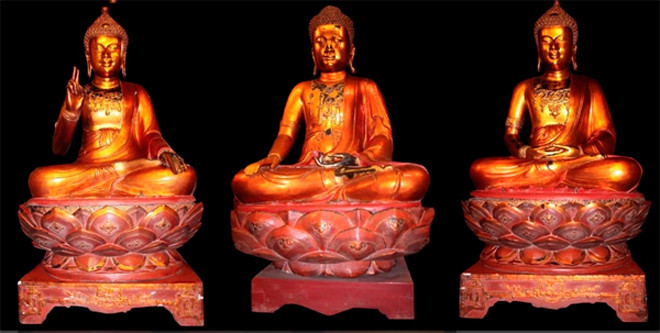The statues, dating back to the Le Trung Hung period, have been recognized as a National Treasure due to their original craftsmanship and historical significance. They represent the pinnacle of Buddhist art from the 17th-18th centuries.
These statues, along with the Thanh Hu Cave Inscription and the Con Son Tu Phuc Pagoda Inscription, form a crucial part of the UNESCO nomination dossier for the Yen Tu - Vinh Nghiem - Cn Son, Kiep Bac complex as a World Heritage Site.

According to inscriptions and historical records preserved at Con Son Pagoda, the Triad of Buddha Statues is the oldest set of statues in the pagoda, dating back to the 17th century. These statues are unique originals that have been preserved in their entirety from the Le Trung Hung period to the present day.
The Triad of Buddha Statues includes three Buddhas: the Past Buddha, the Present Buddha, and the Future Buddha. Collectively known as the “Three Eternal Dharma Bodies,” they symbolize the eternal existence of the past, present, and future, transcending physical attributes, names, or forms of the tangible world, and existing independently of space and time.
Another interpretation is the “Three Worlds of Three Thousand Buddhas,” comprising the “Past World” with 1,000 different Buddhas, the “Present World” with another 1,000 Buddhas, and the “Future World” also with 1,000 Buddhas. Thus, while the Triad consists of only three statues, they symbolize 3,000 Buddhas across three great eons, each eon corresponding to 1.344 million years.
The statues are crafted from jackfruit wood, lacquered, and gilded, depicted in a meditative pose on lotus thrones in the "defeating Mara" posture. They are associated with the restoration and construction of the pagoda, showcasing multiple layers of lacquer and gilding, adorned with typical decorative motifs that embody both the refined artistry of previous eras and the idealized beauty of Buddhist philosophy.
What sets these statues apart is their distinctive robe style, where the fabric drapes from the left shoulder diagonally across to the right side, leaving the right shoulder, arm, and half of the chest exposed. This "bare right shoulder" phenomenon symbolizes reverence for the higher beings and is unique to these statues.
Tinh Le